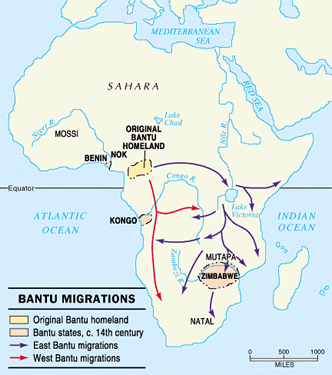
http://www.historyhaven.com/APWH/unit2/bantu_migration.gif
Alex Marden
The area that is now known as The Democratic Republic of Congo has a long human history. Evidence of humans in the area dates back roughly 80,000 years. While this evidence shows that human inhabitants have been present in the area for a very long time, much of the history seems to be shielded by the dense forests of the Congo.
Before the arrival of the Bantu People, during the massive expansion that spread throughout Central and Southern Africa, the forests of Congo were home to hunter-gatherers who relied on the tropical rainforests. These inhabitants, often classified as a Pygmy group, still have ancestors that live within the forests of modern day DRC. Although this native group of hunter-gatherers may still reside within the country, the Bantu expansion displaced a large amount of this group. Linguistic evidence hints at this interaction.
The Bantu expansion started in approximately 1500 BCE. The Bantu people are culturally categorized by linguistics. This group originated in the area that is modern day Cameroon. Along with the massive Bantu expansion came a revolution in the way of life for the inhabitants of Congo. There is a long-standing debate about what prompted the expansion. Some have argued that it was Iron production that led the expansion, but others have concluded that the expansion happened too early for iron to have played a role. What is known is that the Bantu people practiced agriculture. The Congo River played an important role in the expansion into the Congo forests. This was a key transportation route, and also provided a source of water for drinking and agriculture.
The kingdom of Luba was born from the Bantu people in the marshlands of Congo. The kingdom was able to take advantage of technology and resources. Dams were built to aid in agriculture and fish harvesting. Gold and other valuable resources were a key part to the Luba economy. The Kingdom traded preserved fish, gold and other resources. The fact that the Kingdom traded and were not protected by the forest left it vulnerable to colonialism.
The long history of the DRC is still reflected in the country today. It is shaped quite literally by the Congo River. The native Pygmy people depended on it just as the citizens of the modern day DRC depend on it. It was key to the transportation and livelihoods of the Bantu people, just as it is still a major transportation route in the country. The fish from the river have fed the people of the region for centuries. The contemporary diversity in the preparation style of fish in the country today reflects the historic immigrations, migrations, and displacements in the area. These distinctive styles also reflect the isolating power of the dense forest; the same forest that keeps much of the history of the region hidden from discovery. The resources that helped give rise to the Kingdom of Luba and ultimately contributed to its demise still play a major role in the present day DRC.
Works Consulted
http://africa.uima.uiowa.edu/countries/show/7
http://pages.ucsd.edu/~dkjordan/resources/clarifications/BantuExpansion.html
http://www.nbufront.org/MastersMuseums/JHClarke/Contemporaries/LumumbaCongo.html
